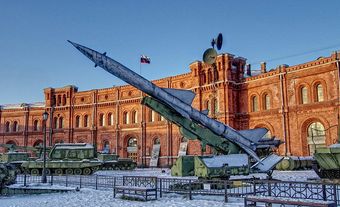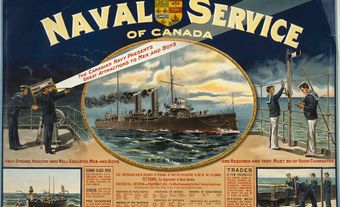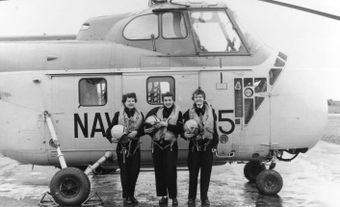The Sound Surveillance System (SOSUS) was a network of passive sonar stations established by the United States Navy (USN) in the early 1950s to “listen” for Soviet submarines. SOSUS was a core element of antisubmarine warfare (ASW) during the Cold War. It developed out of intense postwar oceanographic research into how sound is propagated under water. Given Canada’s shared responsibility for the defence of North America, the Royal Canadian Navy (RCN) was actively engaged in this research and mission and helped operate SOSUS. The mission was highly classified throughout the Cold War and only declassified in 1991. SOSUS became part of the Integrated Undersea Surveillance System (IUSS), a broader network of fixed and towed sensors that remains operational.

SOSUS
The Sound Surveillance System (SOSUS) was based on developments in underwater acoustics. Shortly after the First World War, scientists discovered that sound does not travel under water in straight lines but is bent downwards with decreasing temperature and increasing salinity. In the 1940s, oceanographers discovered the deep sound channel, which became known as the SOund Fixing and Ranging (SOFAR) channel. The SOFAR Channel is a horizontal layer of water through which low-frequency soundwaves can travel thousands of miles.
The idea behind SOSUS was to place long lines of hydrophones called “arrays” at various locations on the continental shelf, aimed into the ocean basins at the depth of the SOFAR or deep sound channel. The collected ocean noise was transmitted ashore by underwater cable to an “oceanographic research naval facility” (NAVFAC), where it was analyzed through a process termed Low Frequency Analysis and Recording (LOFAR). Using rudimentary — but for the time powerful — computers, LOFAR signal processing could determine the bearing of submarines with great accuracy. It could also distinguish between different frequencies related to various machineries, making it possible to detect and classify submarines by type (and sometimes even individual vessels).
A number of NAVFACs were set up as a web along the east and west coasts of North America and across the Greenland-Iceland-United Kingdom (GIUK) Gap. By comparing contact information and bearings, the NAVFACs could triangulate a fairly precise position (in the order of tens of square kilometres). Allied submarines and long-range patrol aircraft such as the RCAF Argus and later Aurora could then be “cued” (despatched) to that position to find the contact — and in wartime to engage it. In this way, Soviet submarines were tracked through their entire deployment in the North Atlantic (coverage was not as consistent in the North Pacific Ocean, which is much larger). The allies believed the Soviets were aware of SOSUS but did not fully appreciate the extent or accuracy of its coverage. Without access to Soviet records, however, this assessment cannot be verified. (See also Canada and Antisubmarine Warfare during the Cold War.)
SOSUS and Civilian Research
Even during the Cold War, the USN permitted some civilian scientists to use SOSUS for research. One of the earliest applications was to measure the speed and direction of deep ocean currents using floats. When the Cold War ended in the early 1990s, the USN allowed more access to SOSUS by civilian oceanographers. SOSUS has been used to study underwater volcanic eruptions and earthquakes, marine mammals and their sounds and large-scale ocean temperature variations.

Canadian Involvement in SOSUS
The RCN was invited to operate a NAVFAC at Shelburne, Nova Scotia, and to cooperate in the running of two others, at Argentia, Newfoundland, and Whidbey Island, Washington. Shelburne was one of the original NAVFACs set up in the first phase of SOSUS, and occupied part of the Second World War naval shore base HMCS Shelburne. It was restyled a Canadian Forces Station (CFS) upon unification of the Canadian Armed Forces in 1968. CFS Shelburne was decommissioned in 1994 and made redundant after the consolidation of other sensors into the IUSS. At the time, it was the oldest NAVFAC in operation.
Did you know?
When the NAVFAC at HMCS Shelburne became operational in 1955, among its first service personnel were five members of the Women’s Royal Canadian Naval Service. This preceded the assignment of women to USN SOSUS NAVFACs by 17 years.
The SOSUS shore terminal at Argentia was established in 1959 on the grounds of the USN Naval Air Station (NAS), which had been part of the 1941 UK–US “bases for destroyers” agreement between British Prime Minister Winston Churchill and American President FDR Roosevelt. Although Canadian sailors helped man the Argentia NAVFAC from the beginning, it only became a joint USN-CAF operation in 1972. It became CFS Argentia in 1975, after which USN personnel continued to assist with the operation until it too was decommissioned in 1994 as part of the IUSS consolidation.
The arrays at Argentia remain in use, remotely operated from the Canadian Forces IUSS Centre HMCS Trinity located in CFB Halifax.
The shore facility on the west coast, at NAS Whidbey Island in the San Juan Islands, Washington, was established in 1987 as the IUSS was being developed; it was therefore referred to as a Naval Ocean Processing Facility (NOPF). Given the successful integration of Canadian SOSUS operations on the east coast and the shared defence of the Strait of Juan de Fuca, it was natural to incorporate Canadian sailors into NOPFWI, where they remain embedded to this date.
In the early 1970s, Canada tried using an array across Lancaster Sound to monitor activity in the Northwest Passage but abandoned the attempt because the cable ashore was regularly cut by pack ice dragging on the bottom. At the same time, they recognized that there was only a small chance of submarine activity in the area, given the perils of under-ice navigation in those relatively shallow waters.
Significance
Soviet attack and missile-firing submarines remained almost permanently on station in the open reaches of the North Atlantic and Pacific Oceans throughout the Cold War, and SOSUS was a critical link in tracking them. The Canadian navy played an important role in the research, development and operation of SOSUS, and continues to be involved in its successor, IUSS.

 Share on Facebook
Share on Facebook Share on X
Share on X Share by Email
Share by Email Share on Google Classroom
Share on Google Classroom





